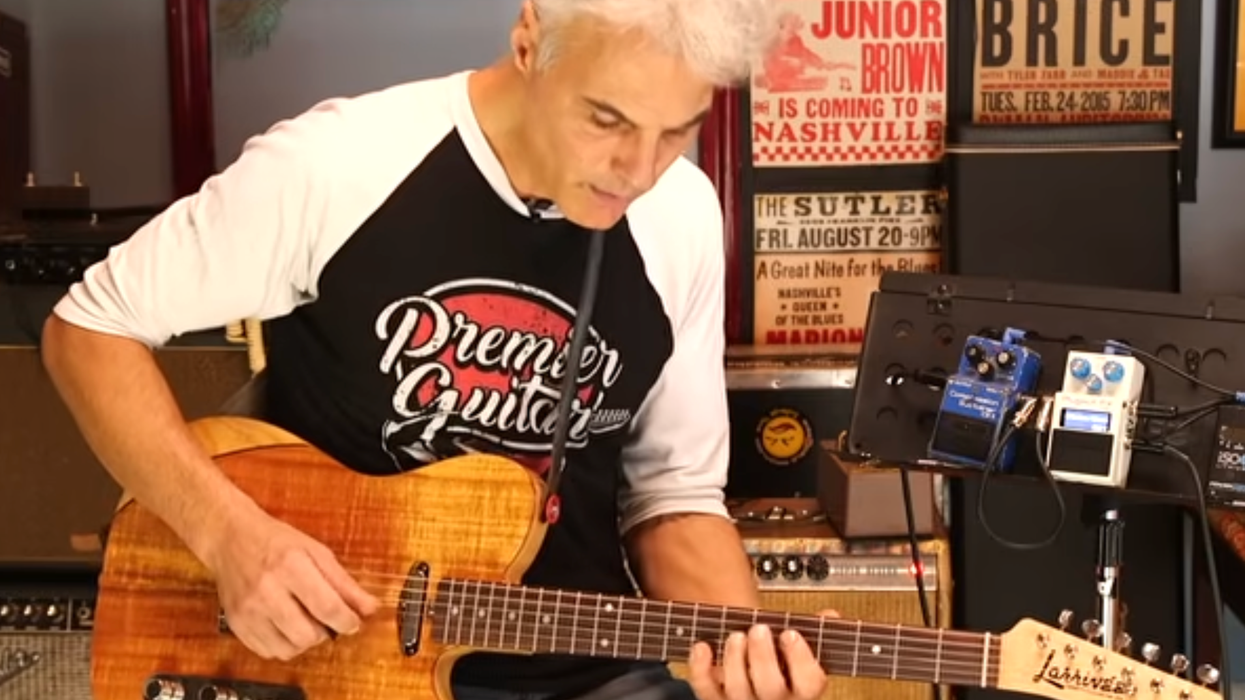RatingsPros:Clear and noise-free. Easy operation after an initial learning curve. Fantastic programming and preset options. Cons: Might be too busy for a player with simple EQ needs. Built-in tuner might be tricky to use in performance. Street: $269 Source Audio EQ2 sourceaudio.net | Tones: Ease of Use: Build/Design: Value: |
Good EQ pedals are very powerful tools, if not the most glamorous. So it might come as a surprise that the original DSP-driven Source Audio Programmable EQ, released in 2011, is among the company's best-selling products. It has high-profile fans in David Gilmour and John Mayer, among others. But in general it enjoyed a fraction of the recognition enjoyed by the company's excellent reverb, delay, or modulation units.
Rarely content to sit still, Source Audio has reimagined the Programmable EQ as the EQ2. The new version effectively doubles the fun while streamlining the interface, adding stereo inputs and outputs and a wealth of bonus features, including a hidden tuner.
The heart of the pedal is 10 fully adjustable frequency bands—ranging from 31 Hz to 16 kHz—that each enable 18 dB of boost or cut. Like many Source Audio designs, the audio is super high-quality. But the unit is also super flexible—enabling simultaneous use of two entirely independent frequency curves when used in stereo. There's also a parametric EQ mode, four stereo or eight mono onboard presets plus 128 MIDI-accessible presets, a 12 dB boost, external expression pedal and tap switch input for additional parameter control and filtering effects, preset scrolling, and an utterly ridiculous number of extra EQ-shaping options when connected to Source Audio's Neuro editing app for Mac and Windows.
Finished? Not quite. There's also an onboard noise gate, a dynamic limiter, and myriad options for connecting and routing the two essentially independent channels of 10-band EQ. Don't confuse this thing with your old scratchy-slider EQ pedal—this thing is loaded with creative potential.
Novel Graphic
If you're most comfortable with simple analog interfaces, you'll need to get in a slightly different head space to make the most of the EQ2—and there is a learning curve. But the EQ2 is well designed from an interface perspective, and programming and operation quickly become second nature once you get into it. Most essential functions can be performed with ease right on the unit itself using the encoder knob. But the Neuro app adds exponentially more flexibility to the pedal once you get comfortable with how it works.
The encoder knob enables selection and adjustment of individual frequency bands and access to deeper functions. New presets can be saved—and old ones selected—via a small push-button to its left. A mini-pot-sized output/boost control doubles as an indicator lamp, lighting up when the unit is engaged. Connection options include dual inputs and outputs, MIDI in and thru, and jacks for the external controller, 9V DC power supply, and USB connectivity. Impressively, it all fits in a brushed-aluminum box just 4.5" x 2.75". The onboard tuner is definitely a bonus, though it's activated via a footswitch-hold maneuver that I might be a little concerned about using mid-gig without accidentally triggering some other function.
Band Wagon
Keep in mind that while Source Audio refers to the EQ2 generically as a “stereo EQ," you can also think of it as two independent EQs. You can route separate EQ profiles to the front of two amps, utilize both EQs in front of and after the pedals in your amp's loop, or as an EQ/solo-boost pedal in the FX loops of two different guitar amps, to boost both simultaneously.
The EQ2 is fantastically flexible and has great range. And sometimes the myriad functions can obscure the fact that the EQ2 simply sounds great. It's clear, transparent, and extremely low-noise, and the dynamic limiter and noise gate are effective at more extreme EQ settings, too, so you can feel confident about exploring the limits of its tone-shifting capabilities without blowing up speakers or listeners ears.
The Verdict
Many players don't know just how valuable an EQ pedal can be. And for newbies that want to toy with a single, radical EQ shift in a set or song, the EQ2 might be more powerful and complex than what they need. For anyone curious about the vast potential of EQ, however, the EQ2 can be a stunning product. It sounds clear and clean. The basic tweaking and preset functions are easy to use. And the roster of bonus features for deep divers is head spinning. For any guitarist looking to tap into the hidden potential of their amplifiers, guitars, and pedals, the EQ2 could well be a revelation.
Watch our demo:









![Rig Rundown: Russian Circles’ Mike Sullivan [2025]](https://www.premierguitar.com/media-library/youtube.jpg?id=62303631&width=1245&height=700&quality=70&coordinates=0%2C0%2C0%2C0)


























